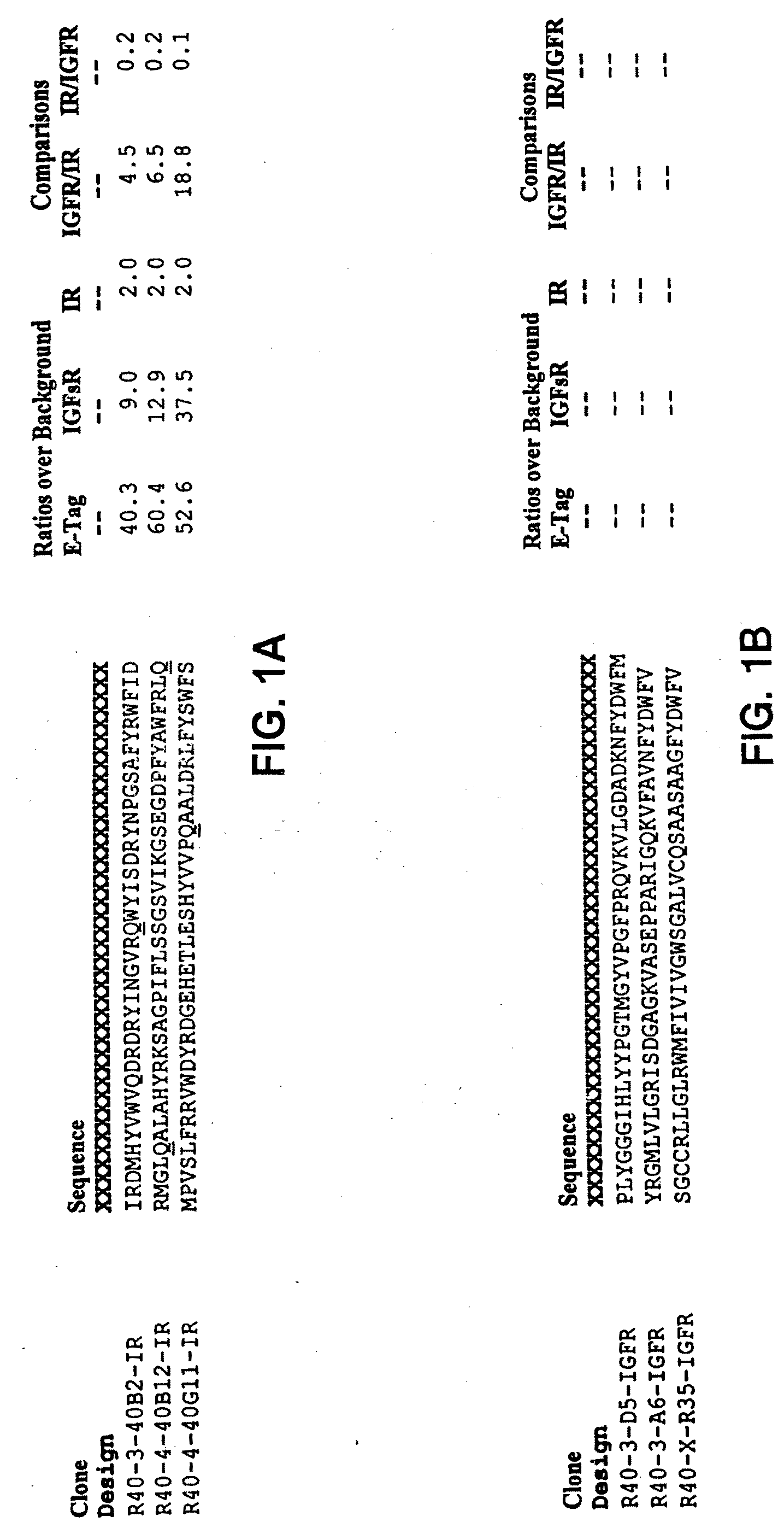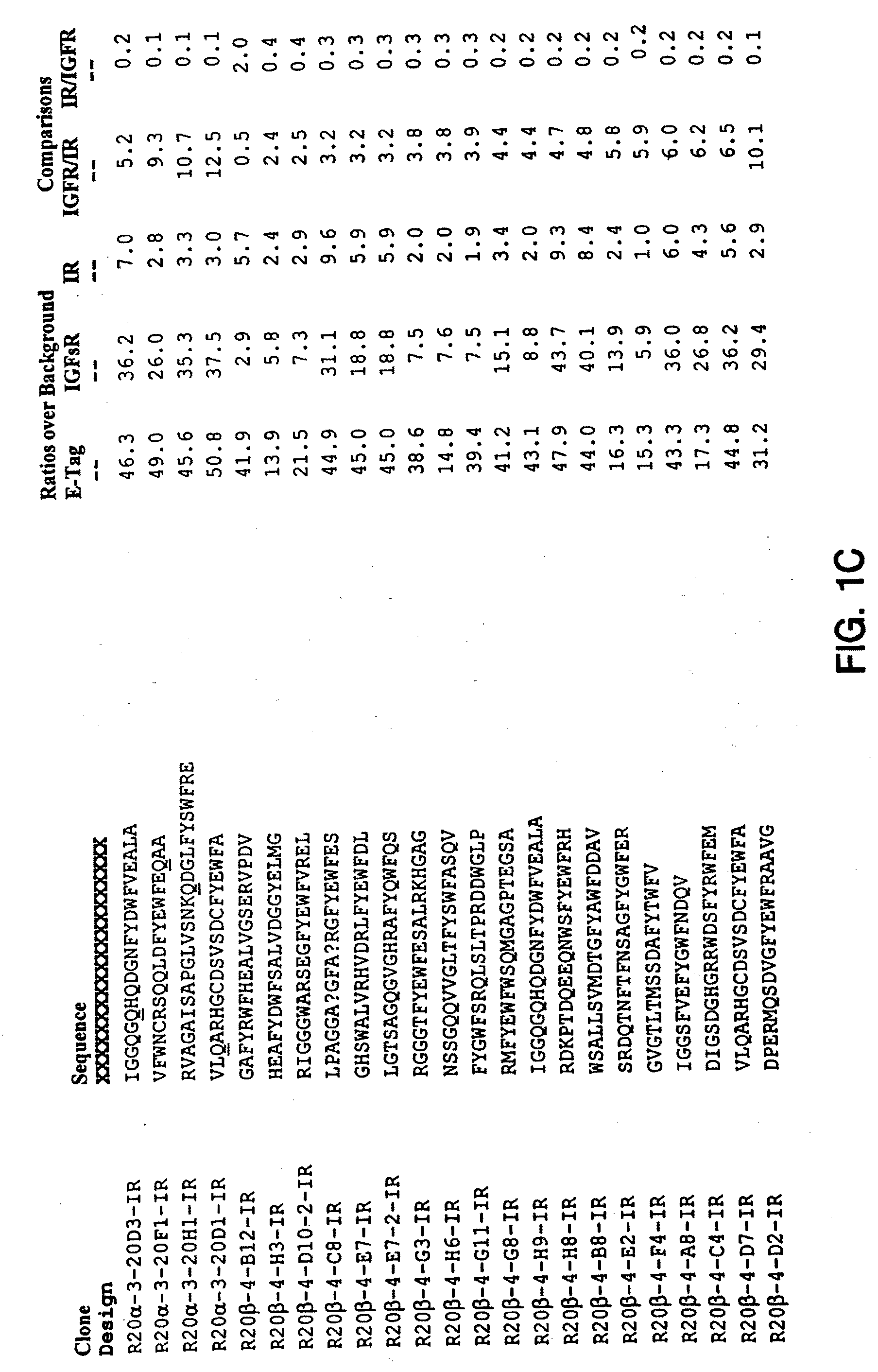Insulin and IGF-1 Receptor Agonists and Antagonists
a technology of igf-1 receptor and agonist, which is applied in the direction of drug composition, peptide/protein ingredient, metabolic disorder, etc., can solve the problems of limited stability in the bloodstream, high production and formulation costs, and inability to achieve effective drug replacemen
- Summary
- Abstract
- Description
- Claims
- Application Information
AI Technical Summary
Problems solved by technology
Method used
Image
Examples
example 1
Monomer and Dimer Peptides
[0308]A. Cloning
[0309]Monomer and dimer peptides were constructed and expressed as protein fusions to a chitin binding domain (CBD) using the pTYB2 vector from the IMPACT™-CN system (New England Biolabs (NEB), Beverly, Mass.). The pTYB2 vector encodes a protein-splicing element (termed intein), which initiates self-cleavage upon the addition of DTT. The intein self-cleavage separates the dimer from the affinity tag, to allow purification.
[0310]In the pTYB2 construct, the C-terminus of the peptide sequence was fused to the N-terminus of the intein / CBD sequence. Two peptide-flanking epitope tags were included: a shortened-FLAG® at the N-terminus and E-Tag at the C-terminus. This fusion was generated by ligating a vector fragment encoding the intein / CBD with a PCR product encoding the peptide of interest.
[0311]The vector fragment was obtained by digesting at appropriate restriction sites the pTBY2 vector. The digested DNA fragment was resolved on a 1% agarose ...
example 2
PEG-Based Dimer Peptides
[0319]A. Synthesis of the Aldehyde Containing Peptide
[0320]The peptide was synthesized by stepwise solid phase synthesis on Rink amide Tentagel (0.21 mmol / g). Three equivalents of Fmoc-amino acids were used. The serine residue was introduced into the peptide by either coupling Fmoc-Ser(tBu)-OH to the N-terminal peptide or coupling Boc-Ser(tBu) to a selectively protected lysine side-chain. The peptide was then deprotected and cleaved from the resin by treatment with 95% TFA (trifluoroacetic acid; aq) containing TIS (triisopropylsilan). Periodate oxidation, using 2 equivalent of NaIO4 in 20% DMSO (dimethyl sulfoxide)-80% phosphate buffer pH 7.5 (45 μl / μmol peptide) for 5 min at room temperature (RT), converted the 2-amino alcohol moiety in an F-oxoacyl group. The peptide was purified immediately following oxidation.
[0321]B. Synthesis of the PEG-Based Dimer
[0322]The unprotected and oxidized peptide (4.2 equivalent) was dimerized on the dioxyamino-PEG (polyethyle...
example 3
Determination of Insulin Receptor Binding
[0324]IR was incubated with 125I-labeled insulin at various concentrations of test substance and the Kd was calculated. According to this method, human insulin receptor (HIR) or human IGF-1 receptor (HIGF-1R) was purified from transfected cells after solubilization with Triton X-100. The assay buffer contained 100 mM HEPES (pH 7.8), 100 mM NaCl, 10 mM MgCl2, 0.5% human serum albumin (HSA), 0.2% gammaglobulin and 0.025% Triton X-100. The receptor concentration was chosen to give 30-60% binding of 2000 cpm (3 pM) of its 125I-labeled ligand (TyrA14-125I-HI or Tyr31-125I-IGF1) and a dilution series of the substance to be tested was added. After equilibration for 2 days at 4° C., each sample (200 μl) was precipitated by addition of 400 μl 25% PEG 6000, centrifuged, washed with 1 ml 15% PEG 6000, and counted in a gamma-counter.
[0325]The insulin / IGF-1 competition curve was fitted to a one-site binding model and the calculated parameters for receptor...
PUM
 Login to View More
Login to View More Abstract
Description
Claims
Application Information
 Login to View More
Login to View More - R&D
- Intellectual Property
- Life Sciences
- Materials
- Tech Scout
- Unparalleled Data Quality
- Higher Quality Content
- 60% Fewer Hallucinations
Browse by: Latest US Patents, China's latest patents, Technical Efficacy Thesaurus, Application Domain, Technology Topic, Popular Technical Reports.
© 2025 PatSnap. All rights reserved.Legal|Privacy policy|Modern Slavery Act Transparency Statement|Sitemap|About US| Contact US: help@patsnap.com



